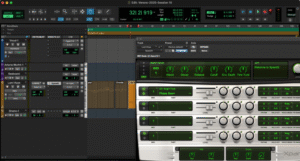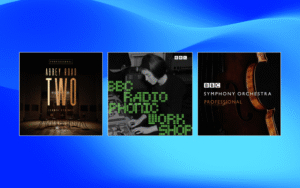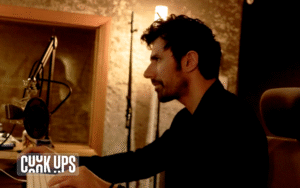The story of Brazilian funk, phonk, and Brazilian phonk is less about genre and more about how online culture flattens nuance instead of enhancing it.
What happens when a country’s grassroots music meets algorithmic globalization? When local culture collides with global algorithms, we get a tension: Phonk may rack up streams and guarantee virality, but funk carries the weight of history, politics, and community. If we don’t try to understand their relationship, we risk flattening the art. We mistake two distinct phenomena as continuous and interchangeable, rather than recognizing the tension created by the simple fact of influence.
To one group, that flattening is experienced violently. To the other, it’s experienced as a revelation—having found an art you resonate with and can build upon, something you didn’t know was out there but had always longed for. To one group, it’s appropriation and lack of acknowledgement; to another, it’s the deepest form of flattery and appreciation.
This will be aided by now table-stakes creation tools like stem separation and the continued sophistication of recommendation systems. It will become even easier to grab bits and pieces of sounds we like while knowing almost nothing about their origins. Phonk is just a harbinger, an early case study of structural changes in the process of influence and creation already underway.
Splice’s internal stats have been telling us two distinct stories: Both “Brazilian funk” and “Brazilian phonk” have been gaining momentum via downloads and searches consistently in the last 18 months. We believe users sometimes use them interchangeably. The genre is hotly contested on Reddit.
In late 2024, a small Splice team traveled to São Paulo for a week’s worth of studio sessions and research. Prior to the trip, we identified BADSISTA as our guide and curator and were lucky to see the city through his eyes. I asked him twice to help us find Brazilian phonk producers, to which he politely replied, “I don’t really know that many.”
Over the course of the week, we spoke with 12 producers, artists, and DJs across Brazilian funk, including d.silvestre, IDLIBRA, BADSISTA, Zopelar, Clementaum, and EVEHIVE about the state of music in Brazil and their hopes for its global future.
Access the world’s best sample library and connected creator tools.
What is Brazilian funk music?
Brazilian funk music is loud, raw, and proudly from the periphery. It started as a hyper-local form of expression, but has evolved into a globally recognized force in electronic music.
“São Paulo is concrete, busy; there’s no space, it’s fun, and aggressive,” BADSISTA says. “It doesn’t give you time at all. Our sound reflects this.”
Common components are blown-out car speakers, metal—sometimes cool sexy metal—and across many of its subgenres, tracks that feature an MC. It sounds urgent and relentless. At moments it sounds atonal, and one of the more reliable sounds you’ll hear from many producers is a bubble, a defining feature of the “beat bolha” subgenre. It uses best-in-class sound design and demands commitment to the crafts of resampling, chopping, and distortion.
Also known as funk carioca, its roots are in Miami bass and freestyle music, which made their way to Brazil in the 1980s through DJs and imported tapes. A defining element is the tamborzão rhythm created in 1998 by DJ Luciano, which stemmed from capoeira and maculelê, an Afro-Brazilian dance with sticks. Before that, funk consisted of MCs rapping over sampled breaks from Miami bass.
Over time, Brazilian producers added their sound, looping rhythmic elements, layering words, integrating prescient social messages, and having unedited fun. Its tempo often ranges anywhere from 120 – 135 BPM.
Characteristics of Brazilian funk
“The first steps of funk were brought from Miami bass, electro, and proto-house”, says ZOPELAR. Funk’s modern incarnation can be linked to a sample from a little-known American ‘80s electro single called “Volt Mix.”
“With time, funk has evolved into more organic sounds, with a growing use of vocals and sampled percussion to build the beats. But, without a doubt, one of the most crucial elements in funk is the voice and rhymes, which are normally part of the rhythm of the song.”
An MC is a crucial component of almost all subgenres across funk, and Clementaum echoes the importance of the vocal: “All across Brazil, there are different types of funk, but they all share a strong vocal presence. Megafunk, bregafunk, and bruxaria are completely different—they can all sample the exact same vocal, but they make it work for their own styles.”
Subgenres of Brazilian funk
Bregafunk
- Origin: Recife, Pernambuco (developed in the late 2000s, and gained national traction by 2018).
- Defining traits: A high-energy fusion of melodic brega and fast-paced funk carioca, marked by off-beat rhythms, cowbells, heavy bass, and passinho dance routines spread through street parties and viral videos.
- Representative artists: Dadá Boladão (Recife), MC Loma e as Gêmeas Lacração (Recife), and Shevchenko & Elloco (Recife).
Bruxaria
- Origin: São Paulo (developed in the early 2020s by the South Zone baile funk scene).
- Defining traits: A dark, chaotic style of funk featuring piercing “tuin” sounds, distortion, reverb, sirens, and glitchy textures. International outlets liken it to horror-infused funk, but locally it’s recognized as an aggressive, experimental branch of São Paulo’s baile funk culture.
- Representative artists: DJ K (São Paulo), DJ Arana (São Paulo), and DJ Blakes (São Paulo).
Funk mandelão
- Origin: São Paulo (emerged in the mid-2010s, popularized by DJ GBR’s “Ritmo dos Fluxos” in 2016; became widespread by 2020).
- Defining traits: Minimalist, bass-driven productions with repetitive lyrics and raw energy, crafted for powerful sound systems and São Paulo’s street-party scene.
- Representative artists: DJ GBR (São Paulo), MC Magal (São Paulo), and MC Menor MR (São Paulo).
At Splice and in the wild
Outside of São Paulo, the highest downloads of Brazilian funk are in Brooklyn, Paris, Berlin, Sydney, Istanbul, Los Angeles, Montreal, Barcelona, Cologne, and Queens. For the last two years, searches for the genre on Splice Sounds increased by an average of 15% each month. Its growth has yet to slow.
Brazilian funk has found fans in Europe, Asia, and North America, where DJs and producers are incorporating its rhythms into club music, pop, and electronic hybrids. Major outlets like Boiler Room and Rinse have focused on artists producing and DJing in this genre, and google searches are up for the genre by 23% year over year.
For many Brazilian artists, that kind of international audience is exciting—but there’s also an interest in preserving it for Brazil as the sound spreads worldwide. “It would be nice to see funk continue to reach more and more audiences; I’m happy to see the evolution of this genre, and proud that it is recognized as true Brazilian music,” says ZOPELAR.
What is phonk music?
Phonk is a bass-heavy style that draws from Memphis rap and the sound that Three 6 Mafia and DJ Paul architected. It was taken to a new aesthetic level when producers in Eastern Europe doubled down on the now quintessential 808 cowbell as a lead and included even more horrorcore elements with the blown-out mixing aesthetic.
“A core emotional trait of the genre is that it’s about feeling powerful,” says sound designer Taylor Shechet. “It’s about defeating overwhelming odds. On the surface, it’s not difficult to produce, but its hyper-modern mixing aesthetic can be tricky and often defies conventional rules.”
Characteristics of phonk
Phonk’s tempo often ranges anywhere between 90 – 110 BPM, with recent iterations going as high as 150 BPM. Its instrumentation often features pitched 808 cowbells, blown-out kicks, phased risers, plucky polyphonic stabs, vocal chops, and horrorcore elements.
Phonk is native to the internet; one doesn’t need to travel to understand its history and evolution. When people are referencing phonk today, it’s likely that they’re talking about drift phonk, but there are several subgenres continuing to emerge.
Subgenres of phonk
Memphis phonk
- Origin: Early ’90s Memphis rap tape culture, which was later revived and popularized as “phonk” in the early 2010s by SpaceGhostPurrp.
- Defining traits: Lo-fi cassette grit, chopped-and-screwed feel, horrorcore atmospheres, and heavy use of vintage Memphis vocals. This darker, slower “classic / new-age phonk” is the template later borrowed (selectively) by drift phonk and, by extension, some Brazilian automotivo producers.
- Representative artists: DJ Screw (Houston), Three 6 Mafia (Memphis), Tommy Wright III (Memphis), and SpaceGhostPurrp (Miami).
Drift phonk
- Origin: Late 2010s, online out of Eastern Europe.
- Defining traits: Fast tempos, hard-clipped 808s, cowbell leads, and pitched and indistinct vocals.
- Representative artists: Kaito Shoma (RU), KORDHELL (UK), Ghostface Playa (RU), and DXRK (DZ).
Aura phonk
- Origin: Russia, 2024.
- Defining traits: Slower edits akin to witch house (sometimes this includes chiptune-like sounds).
- Representative artist: Ogryzek (RU).
Automotivo phonk
- Origin: São Paulo and online—emerged in the late-2010s with its international breakout around 2023.
- Defining traits: Aggressive, blown-out low end, clipped mixes for car sound systems, repetitive hooks, frequent cowbell and 808 patterns, and occasional Memphis vocal chops that overlap heavily with mandelão aesthetics.
- Representative artists: DJ GBR (São Paulo), Bibi Babydoll (Brasília), Slowboy (Oslo), DJ FKU (São Paulo), and DJ Lg do Trap (São Paulo).
Phonk at Splice and in the wild
Though its roots link to Memphis, the genre hit new highs once it was reimagined in Eastern Europe. Kaito Shoma’s ”Scary Garry” is credited with popularizing today’s version of it.
On Splice, the highest downloads are in São Paulo, Brooklyn, Seoul, and Bucharest. In the last two years, searches for the genre increased at least 6% each month, and in July 2025, the term “phonk” hit a five-year high for frequency of searches on Google, growing 400% in the last three years.
The genre has become synonymous with virality, doing huge numbers across streaming and social media platforms. Across Reddit, producers debate the genre’s musicality, with many dismissing it as algorithm fodder. That said, true fans acknowledge its virality and see it as a perfect soundtrack. The world at large heard it in the Fast and Furious franchise, Rebel Moon, League of Legends, and Arcane.
So how did it become Brazilian?
It didn’t. Brazilian elements were borrowed by non-Brazilian producers to create something new. Subsequently, its popularity is growing in Brazil, but so is criticism:
“You mean ChatGPT funk?” said Renate Prado, a dancer, historian, and prominent voice in the world of funk. “How is someone going to make funk without ever having been to a baile and having it get shut down by the police? [Phonk is] a whitewashing of Brazilian funk that makes it easier to understand by the masses. They pick and choose the pieces that they take.”
Brazilian phonk sits at a messy crossroads of Memphis-rooted phonk and Brazilian funk, and the label is used inconsistently. It blends the distinct elements of funk and phonk, namely the tamborzão beat and the maximalist, blown-out mixing aesthetic.
Like Phonk, it’s born out of Eastern Europe and popularized online. At the time of writing this, it’s the soundtrack to the top 10 workout videos on TikTok. Brazilian phonk is hype personified. It keeps the energy at 100 and employs sirens, gun cocks, metallic hits, and risers. Its tempo often ranges between 130 – 160 BPM, with other instrumentation including tamborzão rhythms and vocal chops.
In summary:
| Brazilian funk | Phonk | Brazilian phonk | |
| BPM | 120 – 135 | 90 – 120 | 130 – 160 |
| Parent genres | Miami bass, freestyle, Afro-diasporic rhythms | Memphis rap, trap, lo-fi hip hop | Drift phonk and Brazilian funk |
| Common lyrical themes | Parties, sexuality, street life, empowerment, politics | Drifting, aggression, street culture, darkness | Mostly instrumental, occasional chopped rap or funk vocals, vibe-driven |
| Cultural roots | Favelas and baile funk street parties | Memphis rap, then a global revival in Russia, Brazil, and online | Online-born, heavily produced in Russia but popularity is rising in Brazil |
| Production style | Tamborzão pattern, vocal chops, layered percussion, MCs | Distorted 808s, cowbells, chopped samples, lo-fi saturation, horror atmospheres | High-BPM, distorted 808s, cowbells, EDM-style drops, funk vocal chops (often not actual Brazilian Portuguese), tamborzão patterns |
| Representative sample packs | Clementaum: SOUNDS OF CUZIL, d.silvestre: The New Face of Brazilian Funk, PANDEMONIUM, a Humildes do SC moment | Phonk Essentials, Drift Phonk, Dirty Phonk and Vocals | Viral Brazilian Phonk, Brazilian Phonk Essence, Vocal Brazilian Phonk |
“Phonk É o Caralho”
Very few Brazilian producers are big players in the Brazilian phonk scene. In the year since our trip, we’ve undergone a significant review of our Brazilian phonk catalog and are faced with a question: Do we remove the tag because it’s technically inauthentic, even though it deeply resonates to others? “This is not even Portuguese,” IDLIBRA laughed when we played a vocal sample.
“When they call it Brazilian phonk… Everything about this so-called genre gives me goosebumps,” d.silvestre says. “Covers being made with AI, the sounds, the titles with the wrong Portuguese, the people who listen to it… It makes me sad that an international audience doesn’t understand the standards enough to know what clichés are being broken, and the music loses value. A whole layer of the art is being left out.”
To pretend this tension is simple is to miss the point. The truth is that we are entering an era where genres are less about place and more about platforms. That shift is irreversible, and it will continue to define the next chapter of global music. The newest member of the funk and phonk debate is bounce phonk. The evolution and reinterpretation goes on.
“This is an issue of globalization—it happens, but all you can hope is that people are curious, respectful, and pay homage to those who started something,” BADSISTA says.
On the transcription of the recording, I can hear myself ask quickly after he finishes: “So, if I’m not from São Paulo, is it okay to try?” The group laughed.
“Of course!” BADSISTA speaks for the room. “You just need to acknowledge what you are doing and where it came from. That is always the key and this is the best way to enjoy the music.”
Vocalist and artist Loïc spent most of the hour listening, but did chime in on this point. “As a French African living in São Paulo for ten years, I am still working on it,” he laughed.
Hear the sounds of Global Residency: São Paulo:
October 21, 2025



